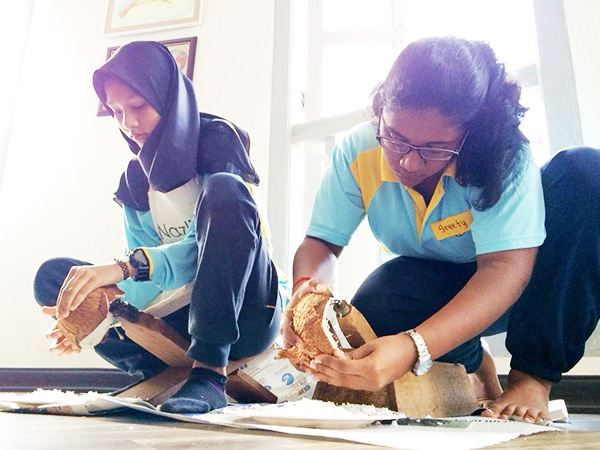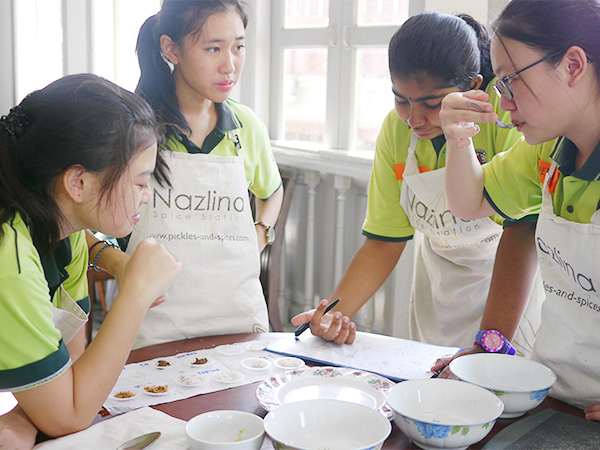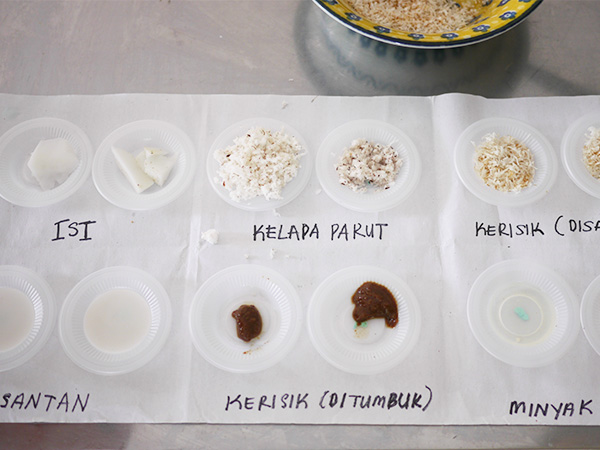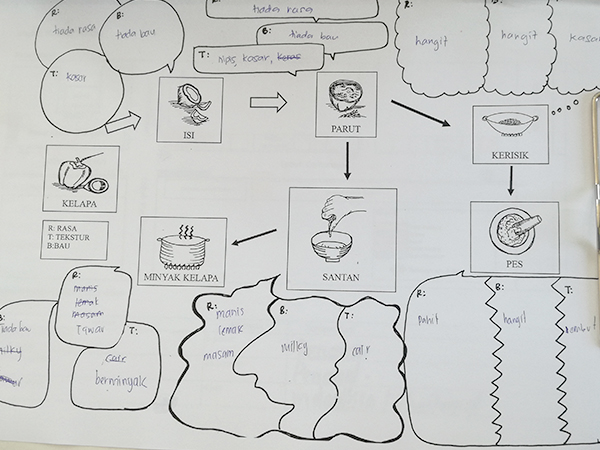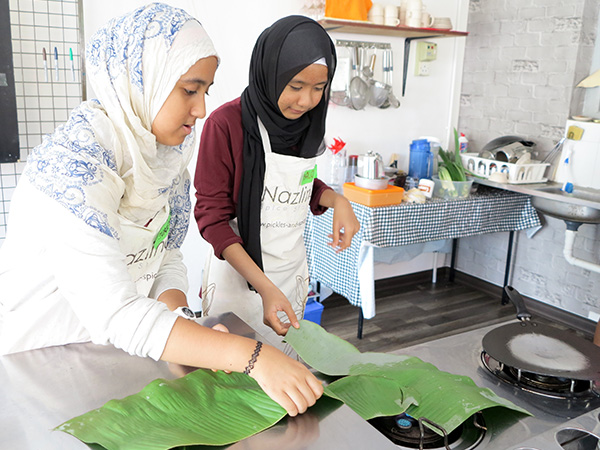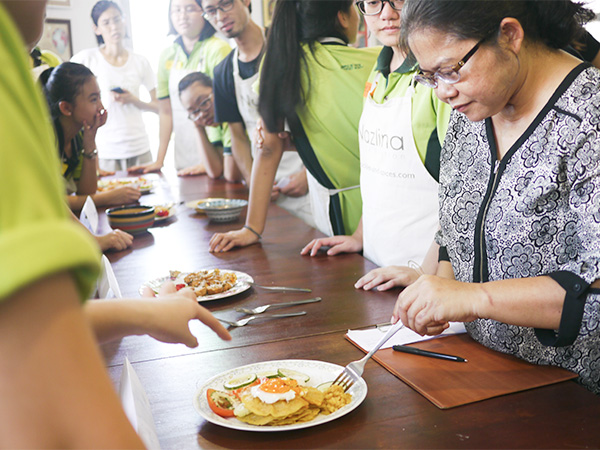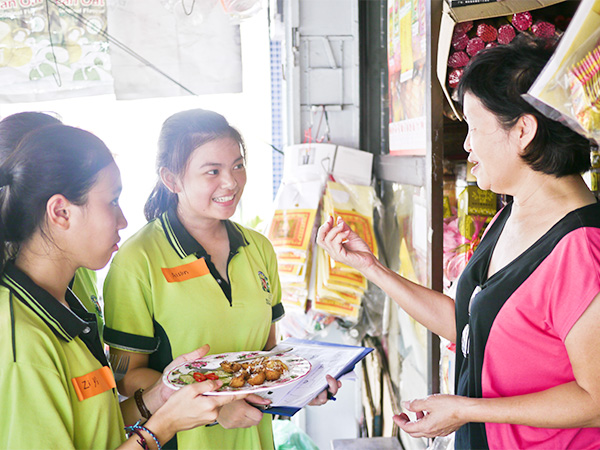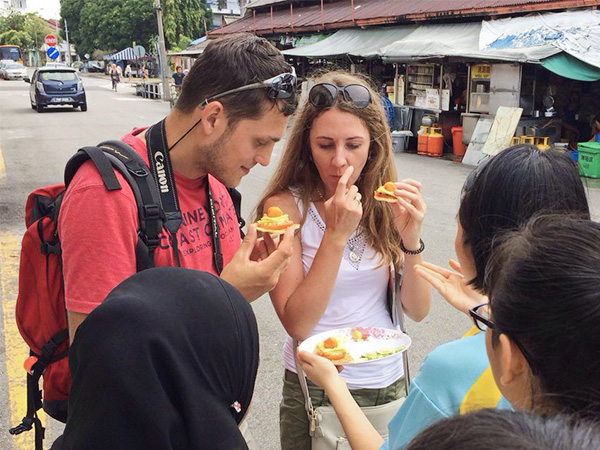Secrets of Coconut
What are the secrets behind ingredients we frequently see in our local dishes? Through hands-on activities, students delve into the cultural significance of ingredients like coconut and their impact on different cuisines, local communities, and the environment.
Project at a Glance
Driving Questions
How do certain food ingredients become important for certain communities or societies? How do different actors in the food supply chain impact these ingredients’ availability and sustainability?
Creative Medium
Cooking
Community
Campbell Street Market
Participants
10–17 year olds
Human Resources
Chef/Cook with knowledge of traditional foods, facilitator with some cooking experience
Timeframe
7 hours
Relevant Subjects
Home Science, Social Studies, Geography

Knowledge
- Understand the uses of coconut in different cultural cuisines and other uses.
- Understand how demand-side factors and the consumers’ considerations influence the sustainability of coconut use, especially regarding waste generation.

Skill
- Develop basic food preparation and cooking skills.
- Demonstrate culinary creativity and experimentation with new recipes using the provided ingredients.

Value
- Appreciate the versatility and importance of using coconut in cooking.
- Appreciate the importance of being a responsible actor wherever one is positioned on the supply chain
Suggested Activities:
- Practise zero-waste behaviour through innovation in cooking.
- Organise cooking sessions that explore the cultural significance of specific food ingredients from different communities.
- Create educational campaigns on social media platforms to inform the community about the impact of their food choices on the availability and sustainability of certain ingredients.
- Initiate a farm-to-table project with local farmers and producers to establish a direct supply chain for specific food ingredients. This project supports local businesses and promotes sustainability by reducing long supply chains.
Context and Citizenship

Some ingredients, like coconut, are not just part of dishes but also play a significant role in the cultural heritage of many communities. They are steeped in tradition, with their uses and meanings varying greatly depending on their cultural group and cuisine. For example, coconut is a staple ingredient in many traditional Southeast Asian dishes and is highly valued for its natural sweetness and versatility.
These ingredients are a testament to the diversity of cultures and the richness of their traditions. They offer a glimpse into different communities’ history, beliefs, and practices and bring to life the intricate interconnections between food, culture, and identity.
Beyond the kitchen, coconut is part of a larger food supply chain affecting usage and availability. From production to consumption, every actor in the supply chain has a role to play in maintaining the sustainability of our lifestyle, where coconut is a culturally significant ingredient and a useful material in other aspects of life.
Components of Learning
Activity 1 - Experimentation with Coconut
Participants were split into groups. As a hands-on introduction to coconut as a cooking ingredient, each group received a half-cut coconut and experimented with it by cutting, grating, frying, squeezing, and boiling the coconut flesh. Participants then recorded their observations of the characteristics of the coconut under the different treatments on a worksheet.
Activity 2 - Dish Preparation and Cooking
To get participants further acquainted with the coconut, the chef demonstrated how to make nasi lemak, a local dish that features coconut as a key ingredient. The demonstration taught participants basic dish preparation skills such as pounding, slicing, julienning, chopping, and squeezing, and cooking skills such as heating, grilling, sauteing, steaming, and boiling. Participants then attempted to prepare and cook nasi lemak in small groups.
Activity 3 - Exploration at the Market
After the facilitator conducted a brief market orientation, participants completed the following tasks in small groups:
- Purchased all ingredients in the shopping list provided (to be used later in Activity 6) while paying attention to their own shopping behaviour, especially reasons that caused them to choose one product over another.
- Researched the demand for coconut by interviewing vendors, covering questions like:
- Which local food/drinks use coconut?
- Besides being a cooking ingredient, what are coconuts’ other uses and functions?
- Who are the customers?
- Are there specific seasons or periods of high and low demand?
- What happens to the excess goods?
- Interviewed consumers who purchased coconut in different forms, including asking questions like:
- What are your criteria for selecting this good?
- What do you use this good for?
- How often do you buy this? How much do you buy?
- How do you handle your waste (fruit and packaging)?
Also observed the consumers to see:
- Whether they use their own reusable shopping bags or rely on plastic bags;
- Whether they avoid excess packaging when selecting goods;
- What kind of packaging materials do they buy; and
- Whether they inspect purchases for signs of spoilage or damage.
Activity 4 - Data Compilation and Analysis
Participants compiled their findings from the market exploration and organised them into three categories:
- Usages of coconut
a. food (specifically named)
b. drinks (specifically named)
c. others - Factors that determine how customers choose their purchase
- Types of waste generated and how it is handled
Activity 5 - Reflection on Responsible Consumption
Participants watched a video on how consumers buy local ingredients and seek to reduce wastage. Participants then compared their observations of consumer behaviour in the market. They also brainstormed strategies for responsible consumption and reflected on their findings.
The following are suggested videos for screening:
Zero Waste Grocery Shopping with Zero Waste Malaysia! (3:28)
https://www.youtube.com/watch?v=T4UIF3a3tvs
Why Zero-Waste Grocery Shopping Matters | One Small Step | NowThis (7:32)
https://www.youtube.com/watch?v=eQDCg8uolUE
To give a fuller picture of the coconut industry and demonstrate the interconnection between supply and demand, the facilitator shared some data on the current state of the coconut supply chain in Malaysia, such as:
- the price of locally grown coconuts can be 2–3 times more expensive than coconuts imported from neighbouring countries like Indonesia, Thailand, and the Philippines;
- the current supply of coconuts is unable to meet local demand – 100 million to 220 million coconuts need to be imported annually, especially during festive seasons;
- some factors at various levels that influence local production are:
- coconut species grown (local level)
- government investment priority in crops other than coconut (state and national level)
- changing demand for coconut products and other main products important to local and national economy (global level)
Building on the participants’ understanding of the coconut supply chain, they were shown a video of how a coconut manufacturer in Malaysia utilises every single part of coconut in its production process to minimise waste.
LINACO – All that is good from a coconut! (5:12)
https://youtu.be/7GgTVlfDH88
This practice towards zero waste, in tandem with the consumer’s action to avoid generating waste and other responsible consumption practices, can help reduce environmental impact and ensure the sustainability of the coconut supply chain.
Activity 6 - Innovation with Coconut – Practising Responsible Consumption
Part of being a responsible consumer is to minimise waste. With that goal in mind, participants were challenged to create a new dish and a drink that utilises every part of a coconut alongside any of the ingredients they bought at the market.
After planning and cooking within the given time frame, the participants presented their creations to a panel of six tasters – a facilitator, a chef, two members of the public, and two market vendors – who scored the dishes and drinks on taste and creativity using a 1–10-point scale. The scores were combined to determine the winning team. Through this activity, participants were able to connect with their local community.
Finally, participants reflected on their experience of responsible consumption, seeking feedback on their culinary creations.
How to Adapt

Community
What other ingredients are significant to your community that participants could explore instead of coconut or compare and contrast with coconut? For example, consider pandan, nutmeg, or pineapple.

Creative Medium
What mediums might suit participants to practise responsible consumption and share their learnings besides cooking and innovating dishes? You could explore photo-taking, video-making, and creating an awareness campaign.

Topic
What are some ways to deepen the participants’ learning?
- Regarding the topic, you could expand the focus onto the entire supply chain of coconuts in Malaysia and guide participants in tracing the different actors and factors that affect each point of the chain.
- Regarding skills development, you could incorporate language activities, such as debate and essay writing in various formats, as participants explore and articulate their insights on the topic.
This project is adapted from You Think You Can Masak, Cultural Heritage Education Programme (CHEP).
Additional Resources
- “Agriculture: A Coconut Revival” https://agri.upm.edu.my/artikel/agriculture_a_coconut_revival-48955
- “How to Produce Millions of Products from Coconuts” https://youtu.be/hIjzJ-vRRCQ
- SDG 12: Responsible Consumption and Production https://www.globalgoals.org/goals/12-responsible-consumption-and-production/



